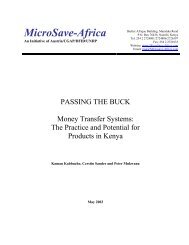Create successful ePaper yourself
Turn your PDF publications into a flip-book with our unique Google optimized e-Paper software.
Mickelwait knew that Barclay had introduced<br />
much-needed business discipline to <strong>DAI</strong>, but<br />
he could not help worrying, as Max Goldensohn<br />
put it, that Barclay’s overall direction was<br />
toward “more business and less development.”<br />
This concern was not really warranted, but Barclay<br />
understood it. “It was almost like a father<br />
feeling that he’d been raising his kids to play a<br />
good role in society and he doesn’t want them<br />
going to work on Wall Street,” he acknowledged<br />
later.<br />
The directors faced a classic dilemma: how to<br />
guide a transition <strong>of</strong> leadership from a charismatic<br />
founder <strong>of</strong> a successful business to<br />
a younger, more buttoned-down successor<br />
who would be able to provide capabilities and<br />
strategy more attuned to the company’s future<br />
needs. Barclay developed the 1999 strategic<br />
plan, which envisioned acquiring IQC “franchises”<br />
to protect <strong>DAI</strong>’s market share and revenue<br />
level with USAID (then $60 million). Aiming for<br />
$100 million in revenue by 2003, he assumed<br />
that <strong>40</strong> percent would come from nontraditional<br />
sources, including Bannock (European revenue),<br />
ECIAfrica (revenue from southern Africa), and<br />
other new initiatives. Barclay believed in making<br />
a commitment to specific targets, including<br />
stock appreciation. Mickelwait had always<br />
been more open-ended in his thinking and less<br />
focused on financial targets.<br />
On March 6, 1999, the directors approved the<br />
new strategic plan and brought the succession<br />
process to a conclusion. On April 9, the last day<br />
<strong>of</strong> <strong>DAI</strong>’s 1999 staff conference, Barclay became<br />
CEO. John Buck, Charlie Sweet, and Don Mickelwait<br />
all attended a “Built to Last Blast” held<br />
that evening. Mickelwait ended the day as <strong>DAI</strong>’s<br />
<strong>of</strong>ficial “Founder and Director.” There had been<br />
some talk <strong>of</strong> providing him with a founder’s<br />
corner <strong>of</strong>fice upstairs from Barclay’s. But Mickelwait<br />
cared too much about the future <strong>of</strong> the<br />
company to hover over his successor once the<br />
process was complete. He moved to Bangkok<br />
and began spending lots <strong>of</strong> time in China, which<br />
was, as he later put it, “as far away as I could<br />
get.”<br />
63



